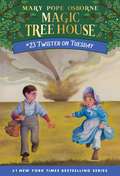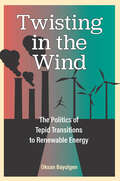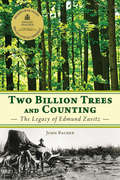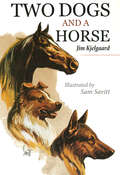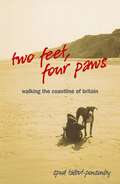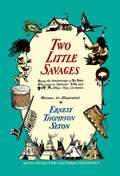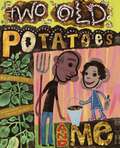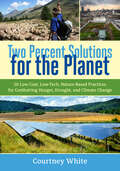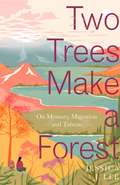- Table View
- List View
Twig and Turtle 1: Big Move to a Tiny House (Twig and Turtle #1)
by Jennifer Richard JacobsonFamily, friendship, new school challenges, and a rather large dog problem combine as sisters adjust to their new tiny house life in this charming chapter book series starter from award-winning author Jennifer Richard Jacobson. Perfect for fans of Ivy and Bean and Judy Moody.In a tiny house, 3 shirts + 3 pants = 9 different outfitsEight- and six-year-old sisters Twig and Turtle are excited and curious about their new small town in Colorado. And for their cool, tiny house! Their family is united in living more simply, and not stressing out the Earth's resources. But the move comes with a major problem: How do you fit a Great Dane in a tiny house?A sweet chapter book series starter with humor and heart, Big Move to a Tiny House is sure to win over fans of Ivy and Bean and Judy Moody.
Twig and Turtle 2: Toy Store Trouble (Twig and Turtle #2)
by Jennifer Richard JacobsonA new toy store in town and a present that comes with all kinds of problems cause Twig and Turtle to question rules that don't always make sense in the second book of the Twig and Turtle chapter book series. Perfect for fans of Ivy and Bean and Judy Moody.Having fun isn't supposed to be such hard work!In their tiny house, the rule is Twig and Turtle are each allowed to have five toys. With a new toy store opening in town, the rule is creating a big problem--getting a new toy means giving up one they love. But when the girls realize that the owner has very old-fashioned ideas about who should play with what kinds of toys, changing her mind might be the biggest problem of all.The second book in the Twig and Turtle series, Toy Store Trouble tackles real-life challenges with humor and heart, and is a perfect pick for fans of Ivy and Bean and Judy Moody.
Twig and Turtle 3: Quiet Please! (Twig and Turtle #3)
by Jennifer Richard JacobsonTiny house living leads to big drama as Twig tries to clock reading hours to bring her class a victory in this third installment of the Twig and Turtle series. Perfect for fans of Ivy and Bean and Judy Moody.The tiny house is too loud!Twig's participating in her school's read-a-thon, but it's hard to concentrate with Dad watching TV, and Turtle trying to blow gum bubbles or showing off the tiny house to curious passers-by. And when Twig's classmate Matteo starts logging more reading time than her, she's desperate to get back her lead, even if it means staying up way past her bedtime.But when Mom and Dad find out what's been going on, it's time to make some changes to the tiny house rules. Can they find a way to make alone time in a family that's so squished together?Sweet and bright, Quiet Please!, the third book in the Twig and Turtle chapter book series will be loudly cheered by fans of Ivy and Bean and Judy Moody.
Twilight of the Hemlocks and Beeches (Keystone Books)
by Tim PalmerIn this magnificently illustrated book, conservationist and celebrated outdoors photographer Tim Palmer launches us on a revealing journey among the hemlock and beech trees that have for millennia towered over America’s eastern woodlands. The eastern hemlock and North American beech once thrived from Maine to Georgia, casting shade on trout streams, nourishing wildlife large and small, and gracing uncounted valleys, mountainsides, parks, and backyards. These trees now face tragic decimation by exotic insects and pathogens. Palmer’s photos record the splendor of the cherished hemlock and beech in the same way that pictures of iconic, historic buildings commemorate classic landmarks gone the way of the wrecking ball. And yet, as Palmer underscores in his final chapter, the lessons learned as we address the fate of these trees can help us chart a better course for all wooded landscapes in the years ahead. This story of loss, scientific inquiry, and prospective recovery is vital to understanding nature in our time.As an act of artistic preservation, a report on the science vital to the survival of these trees, and a call to action, Twilight of the Hemlocks and Beeches assures a lasting legacy for this irreplaceable forest community. With more than one hundred exquisite full-color photographs, this book is a must-have for outdoor enthusiasts, natural historians, ecologists, and all lovers of nature.
Twilight of the Hemlocks and Beeches (Keystone Books)
by Tim PalmerIn this magnificently illustrated book, conservationist and celebrated outdoors photographer Tim Palmer launches us on a revealing journey among the hemlock and beech trees that have for millennia towered over America’s eastern woodlands. The eastern hemlock and North American beech once thrived from Maine to Georgia, casting shade on trout streams, nourishing wildlife large and small, and gracing uncounted valleys, mountainsides, parks, and backyards. These trees now face tragic decimation by exotic insects and pathogens. Palmer’s photos record the splendor of the cherished hemlock and beech in the same way that pictures of iconic, historic buildings commemorate classic landmarks gone the way of the wrecking ball. And yet, as Palmer underscores in his final chapter, the lessons learned as we address the fate of these trees can help us chart a better course for all wooded landscapes in the years ahead. This story of loss, scientific inquiry, and prospective recovery is vital to understanding nature in our time.As an act of artistic preservation, a report on the science vital to the survival of these trees, and a call to action, Twilight of the Hemlocks and Beeches assures a lasting legacy for this irreplaceable forest community. With more than one hundred exquisite full-color photographs, this book is a must-have for outdoor enthusiasts, natural historians, ecologists, and all lovers of nature.
Twilight of the Machines
by John ZerzanThe mentor of the green anarchist and neo-primitive movements is back with his first book in six years, confronting civilisation, mass society, modernity and technoculture - both the history of its developing crisis and the possibilities for its human and humane solutions. As John Zerzan writes, 'These dire times may yet reveal invigorating new vistas of thought and action. When everything is at stake, all must be confronted and superseded. At this moment, there is the distinct possibility of doing just that. '
Twin String Quilt Pattern
by Jessica LevittGo bold with big blocks Indulge in your favorite hue (or two!) with fabric designer Jessica Levitt. Bright and bold quilt blocks pair same-color prints with strong solids for depth and lots of personality. Stitch random-width strips to a muslin base for a planned approach to improv. Giant-size blocks join together like a fun puzzle, forming a graphic secondary pattern when you piece the quilt top! Big blocks from bold solids and prints Foundation piecing is fun and easy on muslin fabric Tips from fabric designer and modern quilter Jessica Levitt For quilters of all skill levels Wholesale minimum: 3 units.
Twister
by Darleen Bailey BeardTwo children experience a tornado. Although she sees them safely to the cellar, Mama has to leave Lucille and Natt and go help Mr. Lyle, an elderly neighbor. She tells the children not to open the door until she comes back. But Mama doesn't come back, and Lucille must comfort Natt throughout the terrifying experience of a tornado.
Twister
by Saddleback Educational Publishing StaffThemes: Hi-Lo, Family life, adventure, travel. These traditional reads are brimming with spirited characters and positive values--but with a little extra excitement and bite, so hold on to your hats! Written expressly for the middle grade struggling reader, the series does not contain strong language, edgy themes, or dysfunctional families. In fact, family is the main theme of these titles. And one particular Latino family is the focus with their uncanny knack for finding humor, hope, and colorful personalities--even in unusual circumstances. Written at the lowest reading levels, the 50-page story structure is straightforward and moves the reader through the text quickly and efficiently. Antonio slid down the rope. He held on for dear life. It got darker as the twister moved closer. It was loud. Like a giant freight train!
Twister on Tuesday
by Mary Pope Osborne Sal MurdoccaThe #1 bestselling chapter book series of all time celebrates 25 years with new covers and a new, easy-to-use numbering system! An adventure to blow you away! That's what Jack and Annie get when the Magic Tree House whisks them back to the 1870s. They land on the prairie near a one-room schoolhouse, where they meet a teenage schoolteacher, some cool kids, and one big, scary bully. But the biggest and scariest thing is yet to come! Did you know that there’s a Magic Tree House book for every kid? Magic Tree House: Adventures with Jack and Annie, perfect for readers who are just beginning chapter books Merlin Missions: More challenging adventures for the experienced reader Super Edition: A longer and more dangerous adventure Fact Trackers: Nonfiction companions to your favorite Magic Tree House adventures Have more fun with Jack and Annie at MagicTreeHouse.com!
Twister on Tuesday (Magic Tree House #23)
by Mary Pope Osborne Sal MurdoccaAn adventure to blow you away! That's what Jack and Annie get when the Magic Tree House whisks them back to the 1870s. They land on the prairie near a one-room schoolhouse, where they meet a teenage schoolteacher, some cool kids, and one big, scary bully. But the biggest and scariest thing is yet to come!
Twisting in the Wind: The Politics of Tepid Transitions to Renewable Energy
by Oksan BayulgenWhy do governments insist on fossil fuels? Why do renewables face uncertain and inconsistent legal and regulatory circumstances that slow their market-share growth against fossil fuels? Oksan Bayulgen studies the political determinants of partial energy reforms that result in tepid energy transitions and shifts the geographical focus from front-runner countries of energy innovation to developing countries, which have become the largest carbon emitters in the world. Her in-depth case study of energy policies in Turkey over the past two decades demonstrates that energy transitions are neither inevitable nor linear and that they are often initiated if and only when promoting renewables is in the interests of governing elites and stall when political dividends associated with energy rents change. This book contributes to the debates on the nature and pace of energy transitions by analyzing the power dynamics and political institutions under which energy reforms are initiated and implemented over time. This timely topic will be of interest to scholars, policymakers, energy investors, and anyone interested in environmental studies.
Two Billion Trees and Counting: The Legacy of Edmund Zavitz
by John Bacher Kenneth A. ArmsonShort-listed for the 2012 Speaker’s Book Award Edmund Zavitz (1875–1968) rescued Ontario from the ravages of increasingly more powerful floods, erosion, and deadly fires. Wastelands were talking over many hectares of once-flourishing farmlands and towns. Sites like the Oak Ridges Moraine were well on their way to becoming a dust bowl and all because of extensive deforestation. Zavitz held the positions of chief forester of Ontario, deputy minister of forests, and director of reforestation. His first pilot reforestation project was in 1905, and since then Zavitz has educated the public and politicians about the need to protect Ontario forests. By the mid-1940s, conservation authorities, provincial nurseries, forestry stations, and bylaws protecting trees were in place. Land was being restored. Just a month before his death, the one billionth tree was planted by Premier John Robarts. Some two billion more would follow. As a result of Zavitz’s work, the Niagara Escarpment, once a wasteland, is now a UNESCO World Biosphere. Recognition of the ongoing need to plant trees to protect our future continues as the legacy of Edmund Zavitz.
Two Days in May
by Harriet TaylorBased on a real-life incident that occurred several years ago in Chicago, Taylor tells the story of a city girl who discovers five deer grazing in the small garden behind her apartment building, and how the deer are brought back to safety in the wild.
Two Degrees
by Alan GratzNew York Times bestselling author Alan Gratz (Refugee; Ground Zero) is back, tackling the urgent topic of climate change in this breathtaking, action-packed novel that will keep readers turning pages while making their own plans to better the world. <p><p>Fire. Ice. Flood. Three climate disasters. Four kids fighting for their lives. <p><p>Akira is riding her horse in the California woods when a wildfire sparks—and grows scarily fast. How can she make it to safety when there are flames everywhere? <p><p>Owen and his best friend, George, are used to seeing polar bears on the snowy Canadian tundra. But when one bear gets way too close for comfort, do the boys have any chance of surviving? <p><p>Natalie hunkers down at home as a massive hurricane barrels toward Miami. When the floodwaters crash into her house, Natalie is dragged out into the storm—with nowhere to hide. <p><p>Akira, Owen, George, and Natalie are all swept up in the devastating effects of climate change. They are also connected in ways that will shock them—and could alter their destinies forever. <p><p>Bestselling author Alan Gratz is at the top of his game, shining a light on our increasingly urgent climate crisis while spinning an action-packed story that will keep readers hooked—and inspire them to take action. <p> <b>New York Times Bestseller</b>
Two Degrees
by Alan GratzWhen three children endure separate climate change disasters--a wildfire in the California woods, a close encounter with a hungry polar bear in Canada, and a massive hurricane in Florida--they emerge from their experiences committed to changing the world.
Two Dogs and a Horse
by Jim KjelgaardHere's three of the best short stories from Jim Kjelgaard! Brad was a huge dog and loyal to one man--Jed Fentress. The villagers joked about the 'lion' that walked beside Old Jed; he'd better be careful! When a local man found Old Jed dead on the trail, Brad was a hunted dog! * * * The hill men said nobody could capture that wild horse, and nothing could tame it. Then young crippled Jed Hale did what no other man in the whole valley had done, and the black was Jed's. * * * Johnny raced to the swamp. A gun and Harold had been missing since early morning. Johnny didn't want Harold to do what Johnny might have to do--kill the wounded goose. And what about the goose's companion, a dog?!
Two Feet, Four Paws: Walking the Coastline of Britain
by Spud Talbot-PonsonbyTake one headstrong dog and a feisty young woman, and send them off on a walk for the equivalent distance of London to Delhi. Two Feet, Four Paws is the heart-warming tale of one dog and her woman, who face the daily physical and mental challenges with a sense of humour and more determination with each mile.
Two Feet, Four Paws: Walking the Coastline of Britain
by Spud Talbot-PonsonbyTake one headstrong dog and a feisty young woman, and send them off on a walk for the equivalent distance of London to Delhi. Two Feet, Four Paws is the heart-warming tale of one dog and her woman, who face the daily physical and mental challenges with a sense of humour and more determination with each mile.
Two Little Savages: Being the Adventures of Two Boys Who Lived as Indians and What They Learned
by Ernest Thompson SetonThis is one of the great classics of nature and boyhood by one of America's foremost nature experts. It presents a vast range of woodlore in the most palatable of forms, a genuinely delightful story. It will provide many hours of good reading for any child who likes the out-of-doors, and will teach him or her many interesting facts of nature, as well as a number of practical skills. It will be sure to awaken an interest in the outdoor world in any youngster who has not yet discovered the fascination of nature.The story concerns two farm boys who build a teepee in the woods and persuade the grownups to let them live in it for a month. During that time they learn to prepare their own food, build a fire without matches, use an axe expertly, make a bed out of boughs; they learn how to "smudge" mosquitoes, how to get clear water from a muddy pond, how to build a dam, how to know the stars, how to find their way when they get lost; how to tell the direction of the wind, blaze a trail, distinguish animal tracks, protect themselves from wild animals; how to use Indian signals, make moccasins, bows and arrows, Indian drums and war bonnets; how to know the trees and plants, and how to make dyes from plants and herbs. They learn all about the habits of various birds and animals, how they get their food, who their enemies are and how they protect themselves from them.Most of this information is not generally available in books, and could be gained otherwise only by years of life and experience in suitable surroundings. Yet Mr. Thompson Seton explains it so vividly and fully, with so many clear, marginal illustrations through the book, that the reader will finish "Two Little Savages" with an enviable knowledge of trees, plants, wild-life, woodlore, Indian crafts and arts, and survival information for the wilds. All of this is presented through a lively narrative that has as its heroes two real boys, typically curious about everything in the world around them, eager to outdo each other in every kind of endeavor. The exciting adventures that befall them during their stay in the woods are just the sort of thing that will keep a young reader enthralled and will stimulate his or her imagination at every turn.
Two Old Potatoes and Me
by John CoyOne day at her dad’s house, a young girl finds two old potatoes in the cupboard. “Gross.” But before she can throw them away, her dad suggests they try to grow new potatoes from the old ones, which have sprouted eyes. Told from May to September, the potato-growing season, the story includes all the basic steps for growing potatoes while subtly dealing with the parents’ recent divorce. Just like the new potatoes that emerged from ugly old potatoes, this dad and daughter move on and make a new life together in the face of unavoidable and unpleasant change. Carolyn Fisher’s artwork will be instantly recognizable from her recent picture book debut, A Twisted Tale, and her trademark high-energy art and design infuse joy and humor into this heartwarming story.
Two Percent Solutions for the Planet: 50 Low-Cost, Low-Tech, Nature-Based Practices for Combatting Hunger, Drought, and Climate Change
by Courtney WhiteTwo Percent Solutions for the Planet profiles fifty innovative practices that soak up carbon dioxide in soils, reduce energy use, sustainably intensify food production, and increase water quality. The &“two percent&” refers to: the amount of new carbon in the soil needed to reap a wide variety of ecological and economic benefits; the percentage of the nation&’s population who are farmers and ranchers; and the low financial cost (in terms of GDP) needed to get this work done.As White explained in Grass, Soil, Hope, a highly efficient carbon cycle captures, stores, releases, and recaptures biochemical energy, mitigating climate change, increasing water storage capacities in soil, and making green plants grow. Best of all, we don&’t have to invent anything new—a wide variety of innovative ideas and methods that put carbon back into the soil have been field-tested and proven to be practical and profitable. They&’re mostly low-tech, too, relying on natural resources such as sunlight, green plants, animals, compost, beavers, creeks, and more.In Two Percent Solutions for the Planet, White expands what he calls the &“regenerative toolbox,&” to include holistic grazing, edible forests, biochar, weed-eating livestock, food co-ops, keyline plowing, restoration agriculture, bioenergy, aquaponics, animal power, Farm Hack, bees, bears, wildlife corridors, rainwater harvesting, native seeds, and various other projects from across the United States, as well as in Canada, Europe, and Australia. These short, engaging success stories will help readers connect the dots between diverse, exciting, and pragmatic practices, and inspire them to dig deeper into each individual story and concept, energized by the news that solutions do exist.
Two Tiny Mice: A Mouse-Eye Exploration of Nature (A\natural World Adventure Ser.)
by Alan BakerThis delightfully sweet storybook follows a duo of harvest mice as they explore the countryside. A unique mouse-eye view shows creatures in their natural habitats as the two meet a quiet rabbit, get a peek in an energetic sparrow's nest, and make an amphibious acquaintance near the river. Exploring is tiring, but at the end of the day there is a cozy, warm nest to crawl back into, and the two mice dream of what nature will bring tomorrow. This title features twelve beautifully drawn animals to discover as Baker's award-winning illustrations put fascinating creatures like badgers, ducks, and squirrels at your fingertips. First published in 1990, this captivating story is a celebration of the value and irreplaceable beauty of nature, but it doesn't end there! This revised edition of Two Tiny Mice includes descriptions of all the animals illustrated, so kids can learn about the wildlife right outside their door. A classic book back in print, Two Tiny Mice will nurture curiosity and a lasting respect for the outdoors.
Two Together (Brendan Wenzel)
by Brendan Wenzel"Masterful." – Kirkus, starred review "[A] picture-book charmfest." – Shelf Awareness, starred review "For viewers who are . . . dog people or cat people." – Bulletin of the Center for Children's Books, starred review "[A discovery in] how beings sense the world." – Publishers Weekly, starred review In this companion book to They All Saw a Cat and Inside Cat, a journey home leads to unexpected adventures for a cat and dog. A playful, imaginative story of friendship, empathy, and discovery by Caldecott Honor winner Brendan Wenzel.Cat and Dog are headed home. A simple route lies ahead of them . . . or does it? There’s so much to see and smell and hear, and the two of them experience the world very differently. A stream, for instance, is watery fun for Dog, but it may not be so delightful for Cat!As their journey becomes an adventure full of unexpected twists and turns, Cat and Dog show that it’s possible for two creatures to travel in the world together despite their distinctive perspectives and abilities—and even to appreciate and enjoy them. With the irresistible read-aloud appeal of Brendan Wenzel’s They All Saw a Cat, winner of the Caldecott Honor, this is a funny, exuberant companion tale that’s an imaginative tribute to empathy, friendship, and understanding.RESPECTING DIFFERENCES: Cat and Dog experience life in almost opposite ways. Through their eyes, children will see how the same situation or problem can be handled differently depending on the perspective and ability of the creature living through it, building their empathy and understanding.DELIGHTFUL VISUALS: This picture book is full of visual surprises and Easter eggs, and readers will love turning back to find details that hint at developments to come on the journey. The dog's and cat’s art styles evolve throughout, becoming more developed and exaggerated but ending with a unified style that incorporates both their points of view as their friendship is affirmed and strengthened.ENCOURAGES EXPLORATION: The path home is both a familiar route and a new experience as Cat and Dog make surprising—sometimes unpleasant—discoveries along the way. The subtle message about appreciating the small moments in everyday routines and the possibilities that await when we step outside them is perfect for young readers.BELOVED AUTHOR/ILLUSTRATOR: Brendan Wenzel is a bestselling author, Caldecott Honor–winning artist, and sought-after speaker at schools and libraries. His books They All Saw a Cat, Hello Hello, A Stone Sat Still, and Inside Cat have received multiple awards and starred reviews and are family and classroom favorites.FUN READ-ALOUD BOOK: Rhythmic text coupled with compelling artwork and a comforting ending make this perfect for story time, bedtime, or both!Perfect for:Parents, grandparents, educators, and educatorsPreschool and kindergarten–level readersPet ownersGift givers looking for a fun, interactive family read-aloud bookFans of Brendan WenzelFans of picture books like Hot Dog, The Kissing Hand, What Do You Do With a Problem?, and The Day the Crayons Quit
Two Trees Make a Forest: On Memory, Migration and Taiwan
by Jessica J. LeeI have learned many words for 'island': isle, atoll, eyot, islet, or skerry. They exist in archipelagos or alone, and always, by definition, I have understood them by their relation to water. But the Chinese word for island knows nothing of water. For a civilisation grown inland from the sea, the vastness of mountains was a better analogue: (dao, 'island') built from the relationship between earth and sky.Between tectonic plates and conflicting cultures, Taiwan is an island of extremes: high mountains, exposed flatlands, thick forests. After unearthing a hidden memoir of her grandfather's life, written on the cusp of his total memory loss, Jessica J Lee hunts his story, in parallel with exploring Taiwan, hoping to understand the quakes that brought her family from China, to Taiwan and Canada, and the ways in which our human stories are interlaced with geographical forces. Part-nature writing, part-biography, Two Trees Make a Forest traces the natural and human stories that shaped an island and a family.








